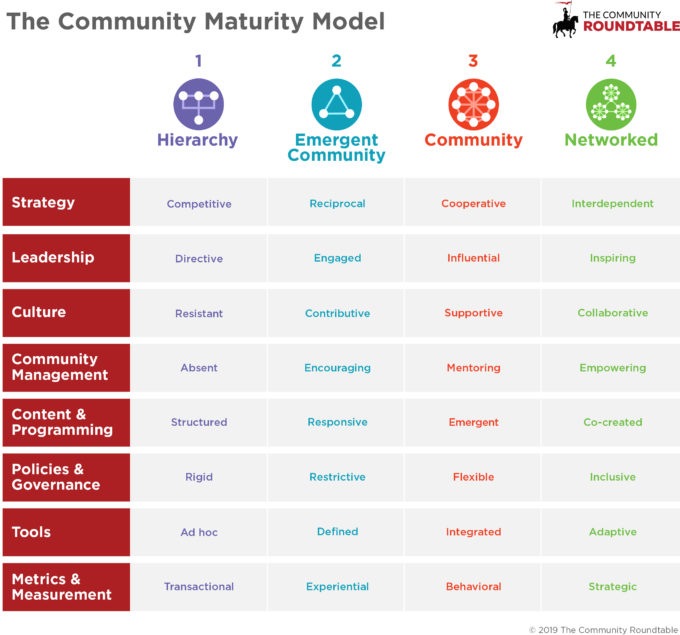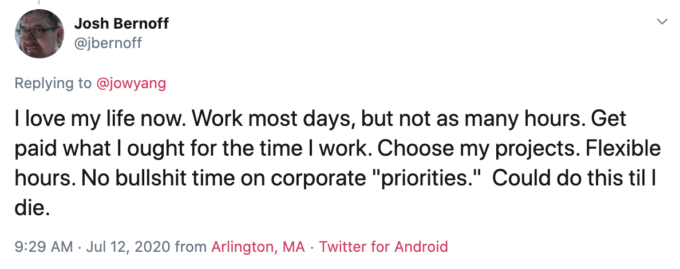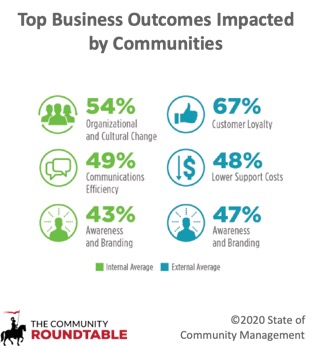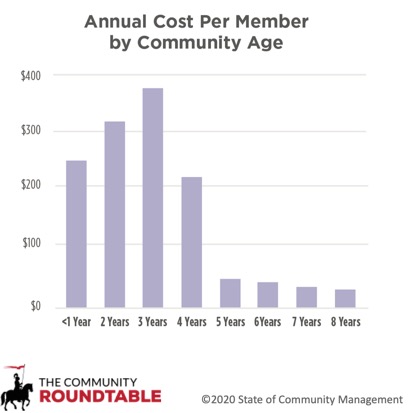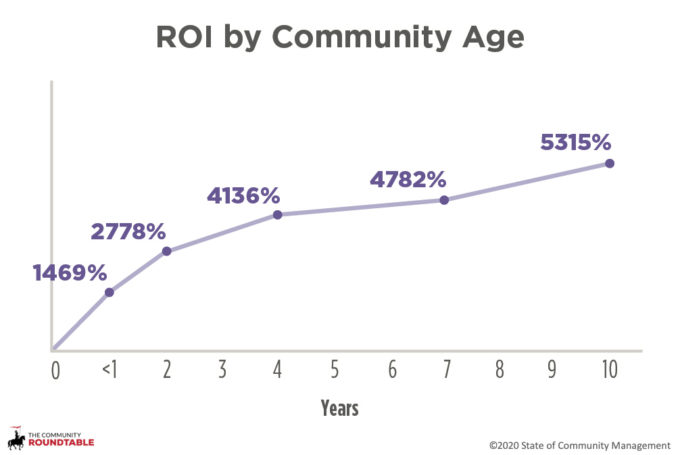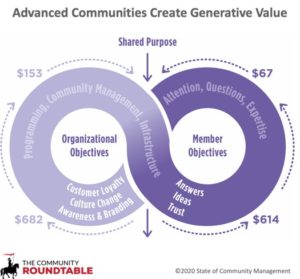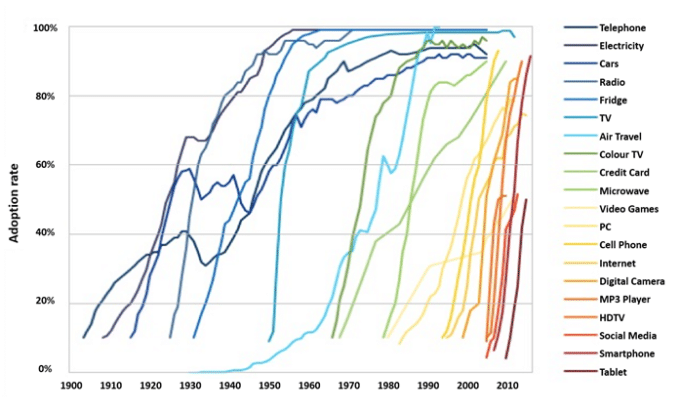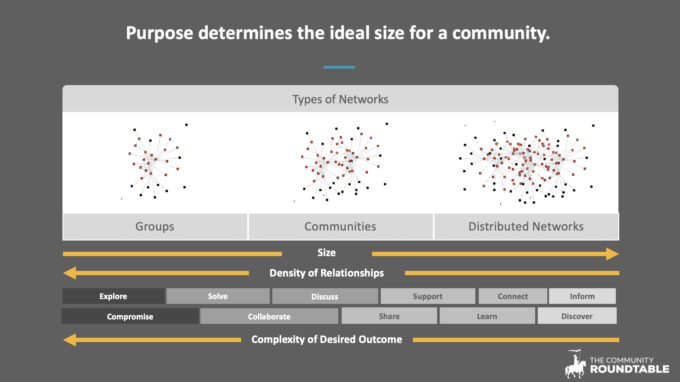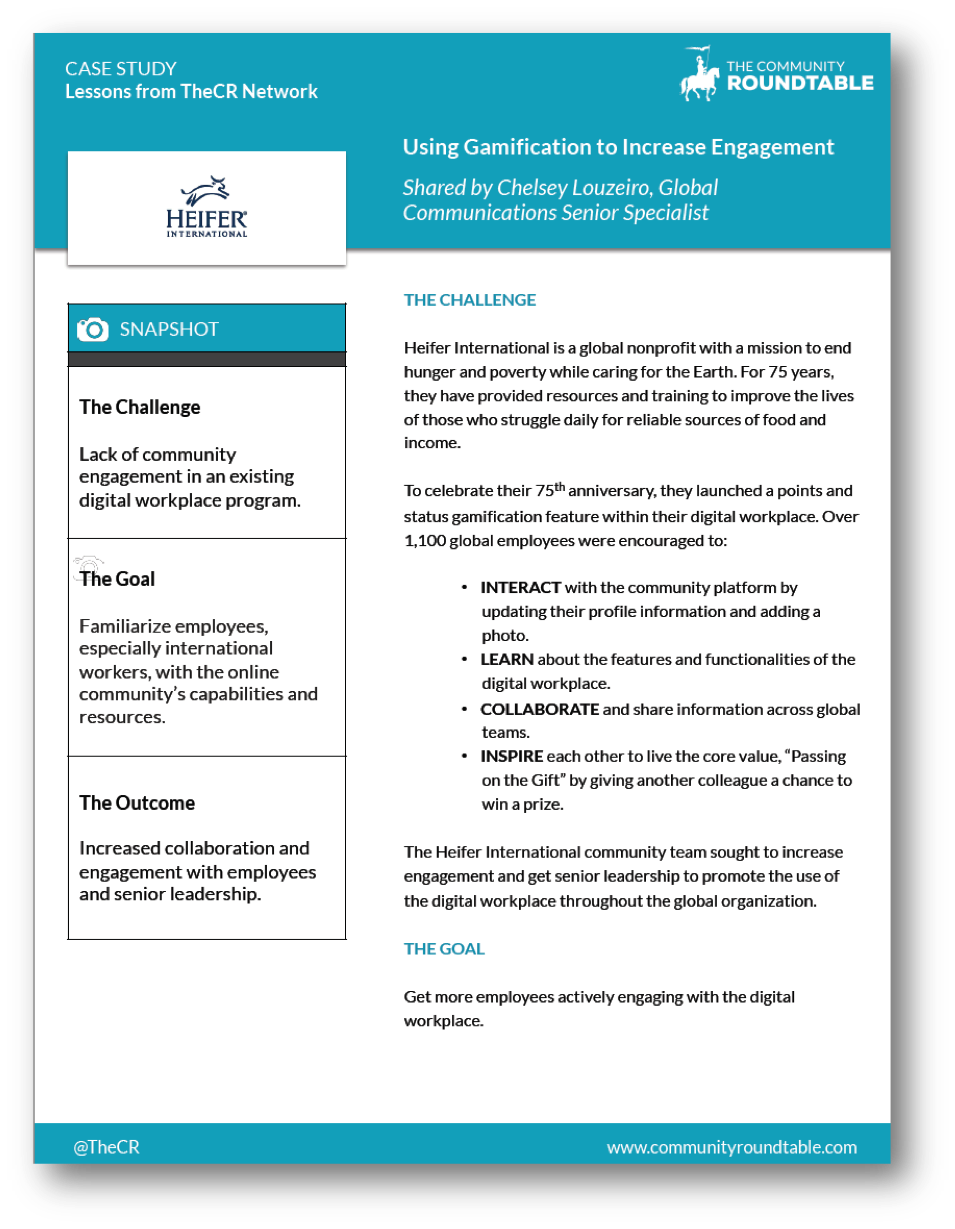
Do you work in or with an organization?
Are you overwhelmed?
Do I even need to ask?
Organizational communications in 2020 is in crisis. Communications channels and content have exploded. Information outside organizations changes with every 60-minute news cycle, while organizational processes and tools seem decades out of date and supported with a fraction of the staff needed. The friction between how fast information flows in public and how slow information flows in organizations increases daily, leaving everyone frustrated, anxious, and immobilized.
In 2011, in a keynote at the Enterprise 2.0 Conference in Boston, I used the Red Queen Hypothesis as an allegory for organizations and their need to change dramatically if they want to survive because the approaches that got them here won’t take them any further. They are, in fact, losing ground – slowly at first and then more rapidly.
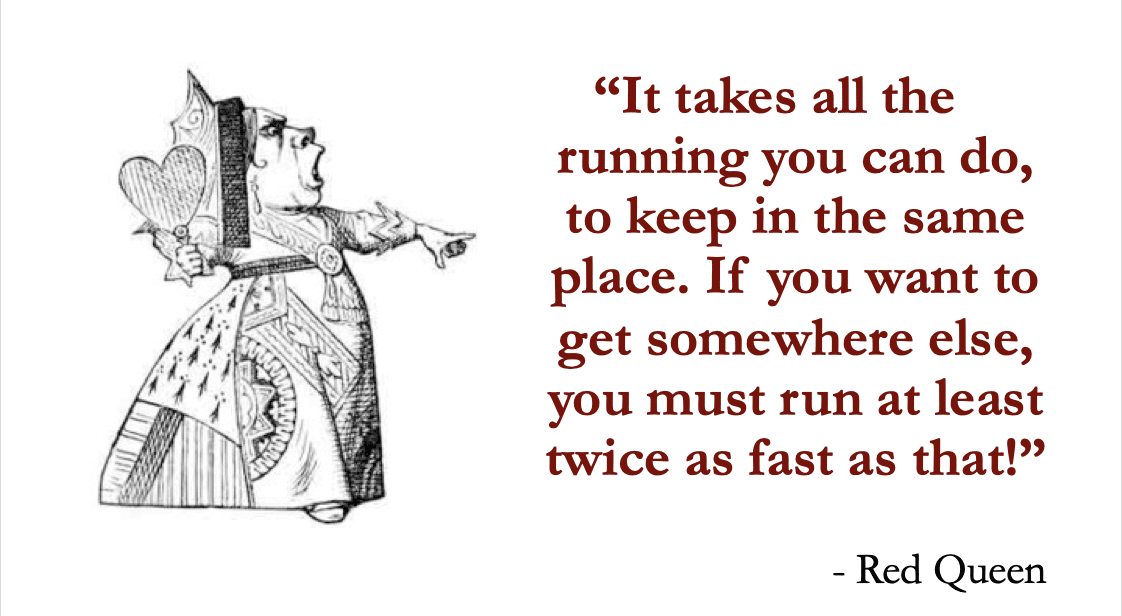
Over the past decade, this dynamic has only increased, with employees in every department running and getting further behind. Organizational boards and executive teams risk extinction by not dramatically restructuring their corporate governance for the knowledge economy. COVID-19 has accelerated that risk. As I projected, people are now the weakest link – they are breaking. Many individuals spend most of their time communicating instead of working – so when do they work? By working longer and longer hours.
The way we have always worked is unsustainable.
Customers Feel Alienated
Customers have noticed. While customers get information on social media, in communities, and through their networks, they often have a challenging time getting anything directly from a person at an organization. The impenetrable fortress is making them wonder what’s going on back there while the world keeps spinning. The silence is often deafening.
When customers can connect, it is more often than not with an online form, an email distribution list, a chatbot, or a faceless social media account. If they need help or an answer from an individual, there are hoops, hurdles, and queues to make it through – a veritable ninja course of obstacles. These experiences leave them feeling burdensome, exhausted, and unappreciated – and very often annoyed. It does not create a good customer experience.
Employees Are Overwhelmed
If you work in an organization, you probably have a contentious relationship with your email inbox. Between the emails, texts, websites, files, chat tools, business systems, community platforms, and social media channels, you are assaulted with information and options. Thanks to the COVID-19 pandemic, you likely added five to eight hours of video meetings per day on top of that.
When do you actually work?
Employees are drowning in information, coming at them from all angles with little rationalization or standardization across different people, teams, and communities within and across organizations. This communications environment is both bewildering and taking an increasing amount of time to navigate. There is little support or guidance, even as organizations continue to deploy and adopt more technology without rationalization, integration, design, or intelligence. Most employees don’t have the skills, the time, the experience, or the access to navigate this ecosystem effectively. So employees tend to default to what they know and are comfortable with even if they also understand it is not effective.
Increasingly overwhelmed and stressed, employees cannot rethink how they work but are in dire need of a reboot. Add with the stress and risk of working through the COVID-19 crisis; there is little incentive to rock the boat or the time to experiment.
HR Is In a Tenuous Position
Human Resources groups have always been primarily tasked with protecting and mitigating the organizational risk of having employees. People are accounted for as liabilities and not assets on balance sheets. Because corporations are set up to maximize shareholder value and profitability, they necessarily seek to minimize their liabilities. One of their liabilities is the cost of employees. This accounting standard puts the incentives of the organization and shareholders at direct odds with employees. HR departments exist to manage and negotiate that inherent conflict with the goal of maximizing contributions while minimizing costs. Trying to improve the employee experience with the fundamental incentives are broken is impossible – and so is dramatically increasing engagement.
Social technologies have increased information and transparency, giving employees more options and better information with which to negotiate. The competitive pressure on HR departments has increased significantly as the balance of power between organizations and individuals have shifted. As we move into a knowledge economy, the friction increases with traditional risk management and HR approaches, which typically seek to standardize roles. Organizations need creative and innovative employees, two things that cannot be forced with extrinsic motivators, which is HR’s primary toolset. HR staff is overwhelmed navigating this new power dynamic while applying the standardized processes, roles, and governance that mitigate risk.
IT Sees the Approaching Storm
IT departments are often the first to see the enormous implications of the changing communications landscape – but with little authority or capacity to address them. Most organizational IT budgets are consumed, supporting legacy technology, ensuring security, and managing users. With the remaining resources, IT teams look to adopt and deploy technology and applications that will help the organization innovate – but most often without the design, UX, consulting, and analytics resources or capacity to help ensure its successful use, rationalization with existing tools, and impact on the business.
Cloud technology has also dramatically changed IT’s role and ability to impact organizational change. Cloud solutions are adopted across the organization as individual groups and departments see the necessity, creating an explosion of technology that is not integrated, used consistently, or managed by the organization. IT has lost much of its control and ability to aggregate data across the organization rendering it impossible to understand, rationalize, report, and act on what is happening. IT is overwhelmed, trying to keep track of all the organization’s technology just to ensure they have it identified and secured.
Executives Remain Isolated
Executives, surrounded by assistants and communication teams and in meetings constantly, see and experience little of the chaos. With a ‘bias toward action’ and a mindset that prefers solutions to problems, they often dismiss issues assuming they are driven by politics or personalities.
The challenges and opportunities for organizations have changed significantly, however. In production economies, the business opportunities were often logical and mechanical; standardizing supply chains and communications increased outcomes. Today, the opportunities for most organizations are complex and include many valid options, most of which are not obviously better than others. This new dynamic requires a far different approach to analysis, decision-making, and leadership. It is a decision-making environment with which many executives are not intuitively comfortable.
Current executives, educated and experienced in a different environment, have little time in their daily routines to explore this shift and little motivation given their past success, which is what got them to their role. These concurrent dynamics are colliding in ways that make change extremely challenging.
Meanwhile, crises are coming in quick waves. Executives are trying to address them in the ways that always have – but by the time they have assessed, discussed, and made decisions, their employees and customers are on to the next crisis. Their decisions and communications, when delivered, are already dated and out of touch with the fast-moving environment around them. These executives are overwhelmed with the pressure to change the organization but little confidence in taking the bold steps necessary and even less comfort with dismantling carefully crafted communications that are reviewed by multiple departments.
Community Managers Are In the Crosshairs
Organizations with limited capacity for direct engagement and small communications teams are using social networks, collaboration, and community channels to connect individuals to each other.
Externally, a small cadre of community managers ensure these channels give customers answers and information – and they do. Communities have been wildly successful at supporting customers, building awareness, and increasing product use – and the 2020 State of Community Management research shows that Advanced Community programs continue to invest and grow these programs and the governance required to support them.
IT groups have also invested in the infrastructure to support employee communities, hoping to relieve some of the communications tangle internally and to fill many of the enormous communications gaps across the organizational ecosystem. This effort, however, has been less than successful. While the infrastructure is available, there is little understanding, interest, and motivation to change. For employees, communication behaviors are driven by power dynamics, and the power dynamics of organizations have not changed. When a community manager (and it is usually only one) is hired to support this change, they typically sit in IT, internal communications, or learning & development – siloed and confined to a narrow objective with no visibility, support, or resources to fundamentally change how the organization works. They see many of the problems, support change in pockets, and see the huge opportunities squandered, but they are completely overwhelmed juggling basic needs against tantalizing opportunities.
Communications is a Mess
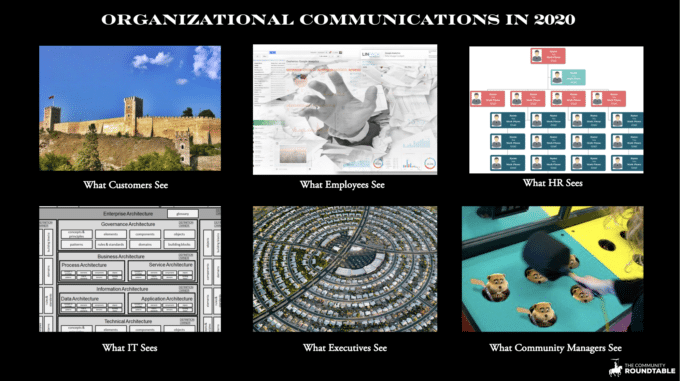
Everyone is overwhelmed. No one has the authority, influence, and expertise to make needed changes.
And the new information environment is impacting and changing every corner of organizations, how they work, and what is possible. In a world where innovation and creativity drive success, how an organization communicates and the culture that creates IS its business model. Communications can no longer be thought of as the group the manages websites and static content. It is a critical driver of becoming an agile and adaptable organization.
Because communications teams are not strategically positioned, the wave of new information channels is overwhelming everyone and pushing them to the breaking point. When used strategically, new communications channels and processes create transparency, easy alignment, more time to work, and increased flexibility. Those organizations that seize the opportunity to dramatically retool their organizations will reap unprecedented rewards in employee loyalty, customer satisfaction, and financial stability.
However, like seized gears, most organizations are stuck because they try to change their approach in any one area on its own – and stalls as it runs into traditional processes in other areas. Without a systemic change to corporate governance – adapting HR policies, management practices and objectives, accounting standards, and metrics – each effort to change communications will hit a wall and revert to the organizational standard, aligning with existing power dynamics and motivators.
I suspect many organizations will not survive because of this challenge and its scope. It is an existential threat that will come quietly at first – and then feel like a freight train bearing down on the organization. How many boards are sensitive to and prepared to act?
Organizations As Communities
Community structures are among the few governance approaches that can address this seemingly chaotic environment by distributing leadership and capacity to its members. As complex adaptive systems, communities are dynamic and diverse enough to react effectively; addressing, and responding to the complex system around them.
When we develop the Community Maturity Model is was, in effect, an organizational governance model designed to help organizations move from rigid and fragile hierarchies to dynamic and adaptive networks of communities. It reflects all the areas that are impacted by a changing information environment and how to nudge each competency into a looser state – from rigid processes and detailed rules to higher-level principals that inform but do not restrict decision-making at the edges. This adaptability allows organizations to evolve in a phased way that leans into its strengths while filling gaps.
What to see where your organization sits?
Take the (free) Community Score Assessment to find out where to prioritize your focus and resources.
Organizational Governance in Crisis
The communications crisis has created division not just within society but within organizations – pushing each functional area to extremes. Everyone is overwhelmed and reacting to that anxiety in different ways. Some groups are shutting down, others are trying to control the chaos by organizing, what is fundamentally unorganizable, and some are denying a problem exists at all.
What do you do when you are running twice as fast and still falling behind?
You need to play a different game.
The old rules are broken beyond repair. Using them is a fool’s errand. Finding a way to fundamentally restructure organizations for a new era is imperative. Global organizations that benefit from market inertia and diversity may not feel the existential threat at the moment but have no doubt it is coming. Watching this space over the past decade, I have seen the impact of this crisis accelerate – and that acceleration will continue and increase in speed.
Organizations need a new governance model – one that does not pit its employees, customers, and partners against itself and each other.
Start with a BOD committee and a strategic task force that includes communications, IT, HR, L&D, KM, a community strategist, finance, legal, and the CEO.
